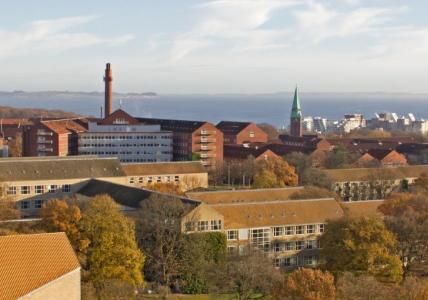The CANAPE project promotes peatland restoration and innovative wet farming to keep vast carbon stocks locked in the ground.
As global temperatures keep rising, the race is on to develop climate-smart solutions.
In fact, one such solution exists right under our noses: Peatlands including fens, bogs and other wet landscapes.
Found in almost every country of the world, peatlands are constantly working to keep climate change at bay and help us cope with its consequences, says Harry Mach from the Broads Authority, manager of CANAPE. This project advances restoration of peatlands and sustainable peatland farming.
Natural wonderlands
Peatlands are characterised by the slow formation of carbon-rich peat - and lots of it. Covering only 3 % of the world’s land area, they keep a staggering 500 giga-tonnes of carbon safe and sealed - that's about 75% of the total CO2 in the atmosphere. Globally, peatlands store twice as much carbon as all of the planet’s forests put together.

Lille Vildmose in Denmark, a CANAPE pilot site, is the largest raised bog in Northern Europe. Originally an expanse of 55 km2, only 20 km2 remains intact.
As if that were not enough, healthy peatlands possess even more amazing features: They act like gigantic sponges, soaking up excess water that they will kindly release during droughts. Just the sort of large-scale buffer we need as more erratic weather kicks in due to climate change.
Yet another key function of peatlands is their capacity to act as natural filters purifying lots of water flowing through them. Finally, they provide excellent habitat for many less common species like the bittern and golden eagle.
In short, peatlands are natural eco-engineering wonders.
Perfect solution or big risk
The flip side is of course that draining or destroying peatlands will not only harm wildlife and disrupt prized water services. It will also unleash the embedded carbon. Draining a peatland the size of a football field will release the same amount of greenhouse gas as driving a car three times around the Earth.
Making sure that this enormous carbon stock stays put exactly where it is seems like a no-brainer. However, Harry Mach says, “many peatlands were traditionally cut or drained and used for growing traditional crops such as potatoes. This practice is continued until this day in many places.”

To kick-start restoration, the Danish Nature Agency stripped the topsoil, raised the water table, and transplanted healthy peat moss from a donor site.
More bad news: Damaged peatlands keep releasing carbon year on year. And they are prone to catch fire, as witnessed by peatland fires across Europe in the dry summer of 2018. The risk of such fires is increasing as global warming leads to more frequent heatwaves.
Some of the largest areas of degrading peatlands are found in Europe, and the EU ranks no. 2 on the global top-25 peatlands emissions list.
Restoring peat to power
How can this situation be addressed? Experts advocate rewetting of degraded peatlands to prevent further carbon release and at least partly restore their ecosystem functions.
CANAPE therefore pilots restoration techniques such as the construction of a clay screen to raise water levels in the largest pilot site, Grenspark in Flanders.
According to Harry Mach, CANAPE will restore almost 100 hectares of peatland including bogs, fens and reedbeds. “We expect these activities to result in direct savings of approximately 1640 metric tonnes of CO2 per year," he says.
It’s all about the money
There are serious barriers to restoring peatlands on a large scale: Restoration is costly, and many drained peatlands are still in use for traditional agriculture. This is why the project promotes ‘paludiculture’ methods for harvesting wetland plants such as mosses, reeds and rushes.
Peatland farming could help cover the restoration costs whilst providing an alternative source of income for the local communities. But paludiculture is facing the same uphill battle as wind energy did 40 years ago. With no market, new technologies, and no supply chain, why would farmers venture into wet farming?
“Many farmers are in fact motivated to make the switch because there is less than one metre of peat left in many places. Once that is gone too, the farmer literally runs out of soil,” Harry Mach explains. “The main obstacle is the business insecurity of growing new crops.”
CANAPE works to create the necessary step-change: Together with local farmers and enterprises, they carry out production and market trials for a series of ‘paludicrops’ and finished products, paving the way by demonstrating the feasibility of each business case.

A fen harvester in action. The CANAPE partners envisage European farmers harvesting ‘paludicrops’ – native plants such as reeds, cattails and sphagnum moss – for eco-innovative products.
In the not so distant future, consumers may be pampering their potted plants with sustainable moss substrate, while farmers might be using purple moor-grass hailing from the local bog to feed their livestock instead of soy that has travelled half the world.
Other products in CANAPE’s pipeline include compost, charcoal, insulation material, paper and cardboard. The Broads Authority is engaging with the cooperative FarmShare to make use of the pilot’s compost and has secured a wholesale agreement for its locally produced charcoal.
CANAPE also explores how restoration and paludiculture can enhance water quality, using advanced monitoring and prediction tools. At least one ‘paludicrop’, cattail, has been shown to effectively improve water quality and reduce CO2 emissions in rewetted peatlands.
This sort of evidence might help speed up peatland restoration. In the UK, water companies are already investing millions of euros into restoring peat bogs. This is seen as a more cost-effective way to procure clean drinking water.
Creating local buy-in
To create awareness and build momentum for their ideas, the CANAPE partners are involving hundreds of local stakeholders. In the Netherlands, local anglers and fishermen are tracking fish stock in lakes using transponders. In Denmark, ‘bioblitz’ events gather local NGOs, experts, and citizens to identify as many species as possible in 24 hours.
The German Bavermoor pilot uses a ‘PaluDialogue Forum’ to discuss with experts and locals. And the UK Broads authority has launched the school campaign What have peatlands ever done for us?

Senior ecologist Andrea Kelly of the Broads Authority works with volunteers on peat coring.
Informing agricultural policy
CANAPE will also raise the awareness of policymakers. Emissions from wetlands will be covered by the European Land Use and Forestry Regulation from 2026. However, Harry Mach says it remains for agriculture policy to recognise the climate virtues of peatlands:
“Currently, growing traditional crops on drained peatland is subsidised, but sustainable peatland farming is not. By demonstrating alternative approaches, we hope to inspire changes in agricultural policy.”
A recent study published by the German Federal Agency for Nature Conservation backs this notion. The study calls for the Common Agricultural Policy (CAP) to incentivise measures that raise water levels – such as rewetting and paludiculture – whilst “strictly penalising drainage-based agriculture.”
May the Peat Force be with us
Managed with purpose and foresight, peatlands can do a tonne of good for us. Managed the wrong way, they are a huge climate fuse waiting to go off due to their immense carbon stocks.

The Hickling Broads is a CANAPE pilot area and part of The Broads, a UK National Park facing multiple public demands for protection and use of the areas.
Although only one-tenth of the world’s peatlands have been drained, these areas alone account for 5.5% of manmade emissions today. And with a growing world population, the pressure is still on to convert these landscapes to other purposes.
Turning the situation around requires policymakers, scientists, farmers, and businesses to come together and drive alternative options forward at speed and scale. By forging such cooperation and showcasing solutions on the ground, CANAPE helps fast-track the transition.



